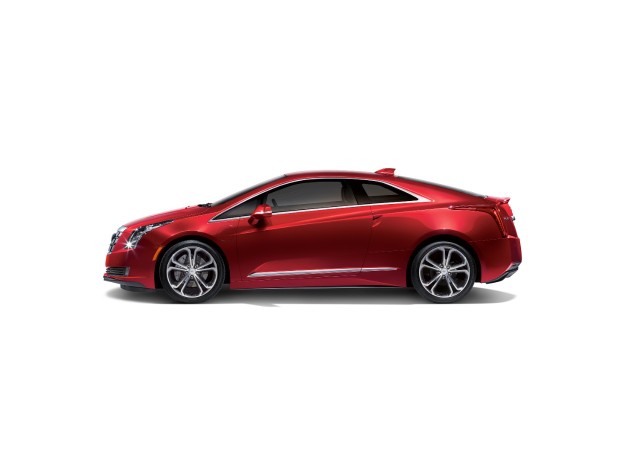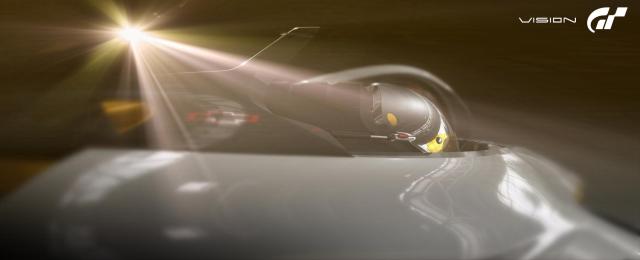
(Photo by Rusty Jarrett/HHP for GM/Chevrolet Racing)
Kevin Harvick (No. 4 Stewart-Haas Racing Budweiser Chevrolet SS) takes the checkered flag and wins the 2014 NASCAR Sprint Cup Series Championship Sunday at Homestead-Miami Speedway in Homestead, Florida. It was Harvick's third win in the Chase and fifth of the season, and his first Sprint Cup Championship. It was yet another manufacturer championship (No. 38) for Chevrolet. See more in Fumes.
 (Photo by Garry Eller/HHP for GM/Chevrolet Racing)
(Photo by Garry Eller/HHP for GM/Chevrolet Racing)
Kevin Harvick (No. 4 Stewart-Haas Racing Budweiser Chevrolet SS) runs ahead of Ryan Newman (No. 31 Richard Childress Racing Caterpillar Chevrolet SS) and Brad Keselowski (No. 2 Team Penske Miller Lite Ford Fusion) at Homestead. Newman finished second.
 (Photos by Richard Prince for Cadillac)
(Photos by Richard Prince for Cadillac)
Cadillac introduced its new Cadillac ATS-V.R racer at the Circuit of the Americas. The new, 600HP ATS-V.R meets international FIA GT3 specifications. The ATS-V.R is the racing extension of the upcoming 2016 Cadillac ATS-V Coupe, which will make its debut next week - along with the ATS-V sedan - at the Los Angeles Auto Show and arrives track-capable from the factory next spring. The ATS-V.R is powered by the LF4.R, the racing version of the Twin Turbo 3.6L V-6 in the Cadillac CTS Vsport. Specific technical upgrades for the GT3-spec race car include larger, twin BorgWarner turbochargers; increased capacity intercoolers; competition engine management and a direct, side-exiting exhaust. The lightweight aluminum block and heads are counterbalanced by a rear transaxle unique to the race car, giving the ATS-V.R a weight distribution of 49 percent front, 51 percent rear.


 (Photos courtesy of Chevrolet/newspressUSA)
(Photos courtesy of Chevrolet/newspressUSA)Known for unconventional, boundary-pushing race cars that shook up the motorsports world, Texas-based Chaparral Cars led by legend Jim Hall partnered with Chevrolet Research and Development more than 45 years ago, pioneering now-standard methods and materials used in contemporary racing and production vehicles, including the composite monocoque chassis, lightweight-alloy powertrain systems, automatic transmissions for racing and progressive, active aerodynamics. The partnership also spawned ground-breaking vehicle data acquisition technology. The Chevrolet Chaparral 2X VGT channels that spirit of innovation into a vision of what the future of racing could hold, with a radical form and an advanced, laser-based propulsion system.
“It was created in a no-rules atmosphere to challenge designers and test engineers to deliver the most exhilarating sensations. This is a fantasy car by design,” said Frank Saucedo, who oversaw the team that worked on the concept. “Like the original Chaparral race cars decades ago, the Chaparral 2X VGT weaves advanced aerospace technologies into the design to help achieve its performance goals.”
Through pioneering applications of aerodynamics and aerospace technology, and a partnership with Chevrolet Research and Development, Chaparral Cars advanced the science of racing cars. It also triumphed on the track over well-established sports car companies from around the world, using Chevrolet horsepower.
It was that spirit of innovation that inspired the Chevrolet Chaparral 2X VGT concept race car developed for the Vision Gran Turismo project, which celebrates the 15th anniversary of PlayStation® racing game Gran Turismo by inviting manufacturers to give fans a glimpse into the future of automotive design. It will debut at the Los Angeles Auto Show, Nov. 19, and gamers will be able race the Chaparral 2X VGT following the release of an online update for Gran Turismo 6 during the holiday season. “Jim Hall and Chaparral blended the art of racing with science in an unprecedented way, changing the sport forever and inspiring a new generation to experiment with aerodynamics and unconventional materials,” said Mark Reuss, GM executive vice president, Global Product Development, Purchasing and Supply Chain. “His race cars were four-wheeled physics projects that proved innovation – and a strong Chevy race engine – could drive you to the winner’s circle.” GM’s Advanced Design Studio, with input from Jim Hall, designed the Chevrolet Chaparral 2X VGT concept. “It will serve as an example of what our designers are capable of when they are cut loose, no holds barred,” said Ed Welburn, vice president of GM Global Design. “A fantasy car in every sense of the word.” The first Chaparral, a conventional, front-engine race car, was built by Dick Troutman and Tom Barnes in 1961. In 1962 Jim Hall and Hap Sharp – who had purchased one of the original Chaparral racers – formed Chaparral Cars, Inc. and immediately began the design and construction of Chaparral 2, a mid-engine car with an aerospace-inspired semi-monocoque fiberglass chassis. It was powered by a 327-cubic-inch Chevrolet small-block V-8 engine and would later incorporate an innovative torque-converter transaxle. In its first race at Riverside, in 1963, Hall qualified the Chaparral 2 on the pole and set a track record in the process. In 1964, he won the United States Road Racing Championship (USRRC) and, in 1965, the Chaparral 2 scored its biggest coup on the racetrack, winning the prestigious 12-hour race at Sebring – upsetting historically dominant international teams. Chaparral Cars soon partnered with Chevrolet Research and Development to help develop the pioneering methods and materials Hall envisioned, including the composite monocoque chassis, lightweight-alloy powertrain systems, automatic transmissions for racing and progressive, active aerodynamics. The partnership also spawned ground-breaking vehicle data acquisition technology. In 1966, Chaparral introduced the radical 2E race car for SCCA’s Can-Am series. With a large, high-mounted wing to produce downforce, it represented a milestone in aerodynamics applied to race cars, providing as much as 240 pounds of downforce at 100 mph. Phil Hill and Hall scored a 1-2 finish that year at Laguna Seca. A year later, the Chaparral 2F, a high-winged coupe build for World Championship Endurance competition, set the fastest lap in five of the eight races that season. Hall’s pursuit of handling-enhancing downforce, which allowed a race car to enter and exit corners faster, while ensuring high-speed stability on the straights, reached its zenith in 1970, with the introduction of the radical Chaparral 2J. In addition to a thundering Chevrolet big-block V-8 engine, it featured a separate motor to drive a pair of fans that exhausted air beneath the car, essentially producing suction-derived downforce. The Chaparral 2J’s unconventional, fan-driven downforce system was as effective as it was controversial. In four races it grabbed three pole positions – and then it was banned by the race series’ sanctioning body. Hall and Chaparral continued racing throughout the 1970s, including the 1970 season of the Trans-Am Series, when Hall drove a Chaparral-prepared Camaro Z-28. The company scored a win at the 1978 Indianapolis 500, with Al Unser Sr. driving a Chaparral-prepared Lola racecar. In 1979, Chaparral built its own Indy car, the 2K, which powered Johnny Rutherford to the Indianapolis 500 win in 1980, along with the USAC and CART series championships that year. The Chaparral 2, 2D, 2E, 2F 2H, 2J, and 2K are displayed in the Chaparral Gallery of the Permian Basin Petroleum Museum in Midland, Texas. The beautifully elegant Chaparral 2 (1963) featured an aerospace-inspired semi-monocoque chassis, advanced aerodynamics for downforce and a mid-mounted Chevrolet engine. The 1966 Chaparral 2E was distinguished by its huge, downforce-generating and driver-adjustable wing, and its side-mounted radiators. It would alter the course of race car design forever. The radical 1970 Chaparral 2J was one of the most innovative racing machines ever built. It used a separate engine to drive suction-generating fans that helped the car stick to the racetrack. It was quickly banned, but its pioneering technologies still resonate today. The Chaparral 2X Vision GT is "an audacious and ambitious vision for Chevrolet," according to GM. It allowed GM's engineering and design teams "to challenge norms and explore the technologies of tomorrow."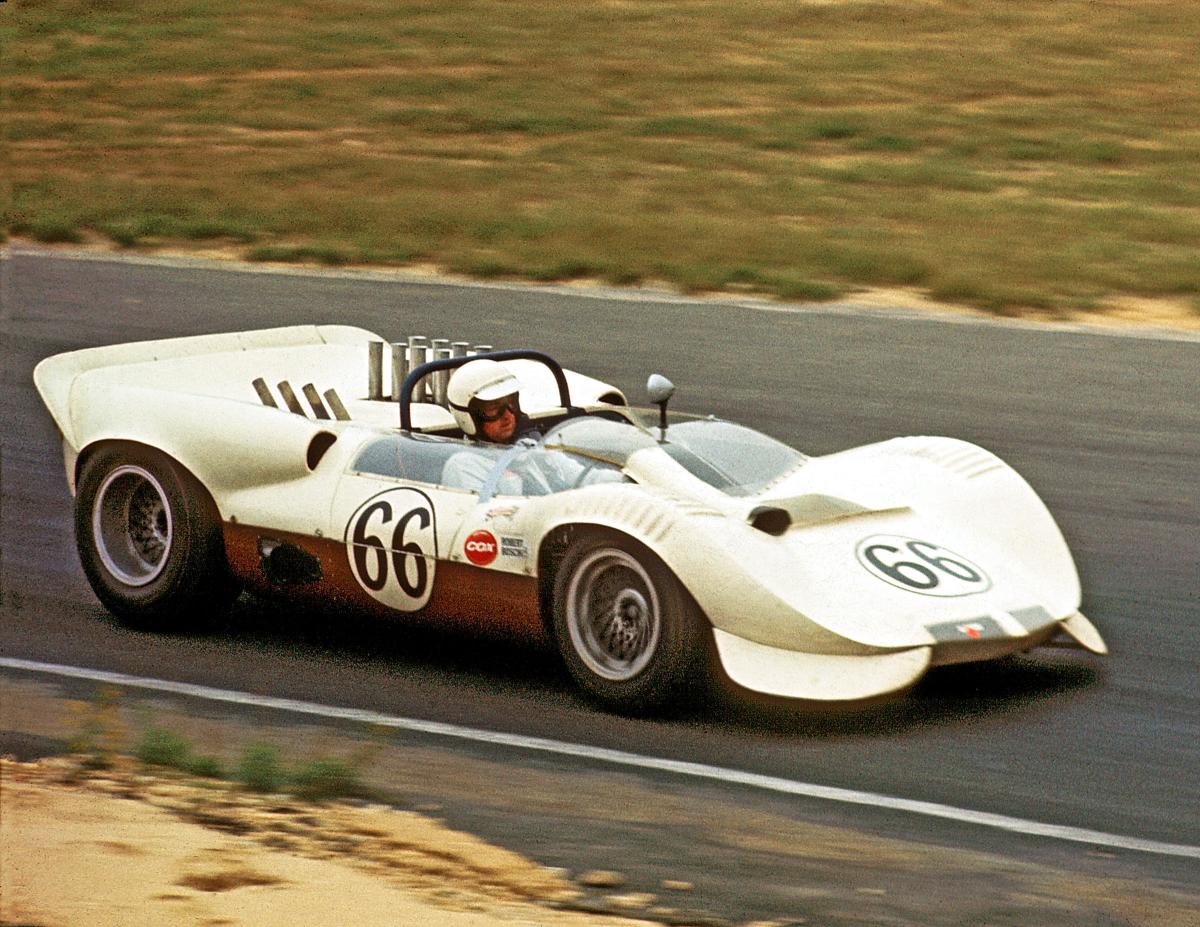
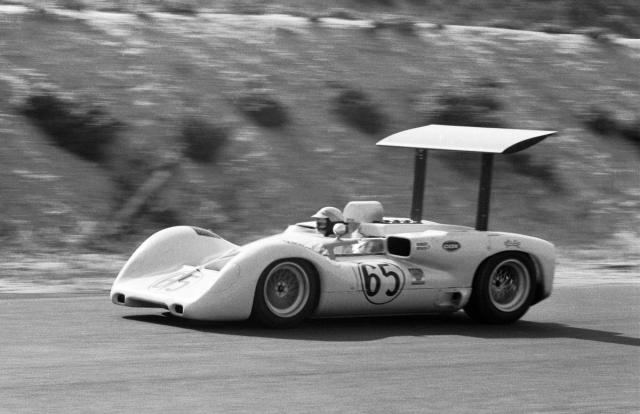
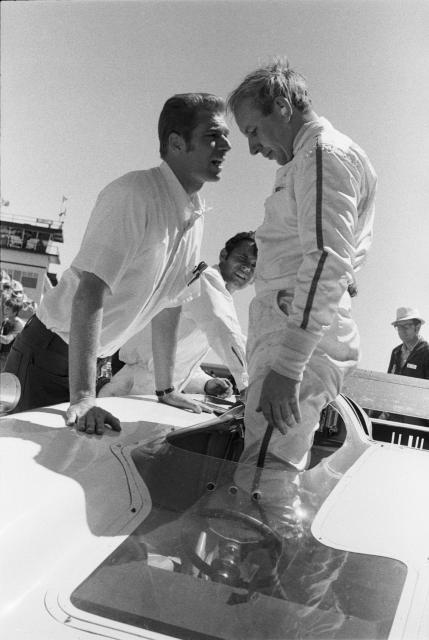 Jim Hall (L) talks with driver John Surtees as mechanic Franz Weis looks on in the pits at the 1969 Edmonton Can-Am, the debut race of the Chaparral 2H. Surtees was not shy about his intense displeasure with Hall's least successful race car design.
Jim Hall (L) talks with driver John Surtees as mechanic Franz Weis looks on in the pits at the 1969 Edmonton Can-Am, the debut race of the Chaparral 2H. Surtees was not shy about his intense displeasure with Hall's least successful race car design.